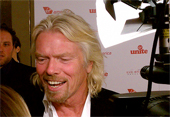How to Become a Better Leader
Good leaders make their work look easy. But the reality is that most have had to work hard on themselves — by managing or compensating for potentially career-limiting traits. To grow as an executive, you need to recognize and manage your strongest tendencies.
Topics

Virgin Group’s Richard Branson has said that he was “shy and retiring” before starting the airline.
Image courtesy of Flickr user andysternberg.
When executives identify a leader they admire, they often underestimate how much that individual may have struggled to curb certain patterns of behavior or certain dominant facets of his or her personality. Great leaders make it look easy. But in truth, the majority of effective leaders that we have observed — even so-called naturals like Virgin Group’s Richard Branson — have worked hard on themselves.
The traits that serve an executive well in one leadership position often do not work well in another. Moving up the hierarchy into new roles or environments, executives may find they need to play up or rein in different facets of their personality. What were strengths can become weaknesses.
Fortunately, advances in personality research can provide executives with a much richer picture of their personality. Psychologists have identified countless traits that distinguish individuals from one another. Research in recent decades has converged toward five broad dimensions, each comprising a cluster of traits. These dimensions appear so robust that they have been dubbed the Big Five. Now widely accepted, the same five factors are found consistently with different research methods, as well as across time, contexts and cultures. (See “The Making of the Big Five.”)
The Leading Question
How can leaders recognize and manage their psychological preferences?
Findings
- Executives need to understand their natural inclinations in order to modify them or compensate for them.
- Most successful executives have had to work hard on themselves.
- Leaders need to recognize their outlier tendencies and learn how others perceive those tendencies.
References
1. Labels for the Big Five have varied, particularly the “N” dimension, which is also known as “negative emotionality” or “neuroticism.” We prefer the more neutral term “need for stability.”
2. T.A. Judge, R.F. Piccolo and T. Kosalka, “The Bright and Dark Sides of Leader Traits: A Review and Theoretical Extension of the Leader Trait Paradigm,” Leadership Quarterly 20, no. 6 (December 2009): 855-875.
3. A. Bryant, “He Was Promotable, After All,” New York Times, May 2, 2009, 2.
4. M.D. Lieberman and N.I. Eisenberger, “Neuroscience: Pain and Pleasures of Social Life,” Science 323, no. 5916 (Feb. 13, 2009): 890-891.
5. R. Hogan, G.J. Curphy and J. Hogan, “What We Know About Leadership: Effectiveness and Personality,” American Psychologist 49, no. 6 (June 1994): 493-504.
6. T.A. Judge, J.E. Bono, R. Ilies and M.W. Gerhardt, “Personality and Leadership,” Journal of Applied Psychology 87, no. 4 (August 2002): 765-780.
7. J.-F. Manzoni and J.-L. Barsoux, “The Set-Up-to-Fail Syndrome” (Boston: Harvard Business School Press, 2007).
8. K. Howe, “On the Record: Carol Bartz,” San Francisco Chronicle, Feb. 15, 2004, sec. I, p. 1.
9. A. Erez, V.F. Misangyi, D.E. Johnson, M.A. LePine and K.C. Halverson, “Stirring the Hearts of Followers: Charismatic Leadership as the Transferal of Affect,” Journal of Applied Psychology 93, no. 3 (May 2008): 602-616.
10. Judge et al., “Personality and Leadership.”
11. All quotes from P. Hemp, “A Time for Growth,” Harvard Business Review 82, no. 7/8 (July/August 2004): 66-74.
12. A. Bryant, “Structure? The Flatter, the Better,” New York Times, Jan. 16, 2010, 2.
13. Judge et al., “Personality and Leadership.”
14. L. Mitchell, “Ten Things I Don’t Put on My CV: Sue Murray,” Age (Melbourne, Australia), Oct. 25, 2008, 3.
15. D.L. van Knippenberg, D. De Cremer and B. van Knippenberg, “Leadership and Fairness: The State of the Art,” European Journal of Work and Organizational Psychology 16, no. 2 (March 2007): 113-140.
16. A. Bryant, “68 Rules? No, Just 3 Are Enough,” New York Times, Nov. 21, 2009, 2.
17. B. George, P. Sims, A.N. McLean and D. Mayer, “Discovering Your Authentic Leadership,” Harvard Business Review 85, no. 2 (February 2007): 129-138.
18. L. Zalaznick, “The Best Advice I Ever Got,” Fortune International (Europe), July 6, 2009, 35.
19. A. Murray, “PepsiCo’s Indra Nooyi on the Trade-Offs She Made,” Wall Street Journal Europe, April 12, 2011, sec. R, p. 5.
20. K. Ely, L.A. Boyce, J.K. Nelson, S.J. Zaccaro, G. Hernez-Broome and W. Whyman, “Evaluating Leadership Coaching: A Review and Integrated Framework,” Leadership Quarterly 21, no. 4 (August 2010): 585-599.
21. George et al., “Discovering Your Authentic Leadership.”
22. Manzoni and Barsoux, “The Set-Up-to-Fail Syndrome.”
23. R. Goffee and G. Jones, “Why Should Anyone Be Led by You?” Harvard Business Review 78, no. 5 (September 2000): 62-70.
24. M. Harrison, “Space Is Not the Final Frontier for the Virgin Boss,” Independent, Dec. 11, 2004, 61.
25. G. Rifkin, “How Richard Branson Works Magic,” Strategy + Business 13 (November 1998): 53-59.
26. B. Fryer and T.A. Stewart, “Cisco Sees the Future,” Harvard Business Review 86, no. 11 (fourth quarter, 2008): 72-79.
27. F. Carlin, “The Art of Influence,” Psychology Today, Sept. 6, 2011, 64-69.
28. A. Lashinsky, “Apple: The Genius Behind Steve,” Fortune, Nov. 24, 2008, 70-80.
i. P.T. Costa and R.R. McCrae, “The NEO Personality Inventory Manual” (Odessa, Florida: Psychological Assessment Resources, 1985).
ii. T.J. Bouchard Jr. and M. McGue, “Genetic and Environmental Influences on Human Psychological Differences,” Journal of Neurobiology 54, no. 1 (January 2003): 4-45.
iii. J. Specht, B. Egloff and S.C. Schmukle, “Stability and Change of Personality Across the Life Course: The Impact of Age and Major Life Events on Mean-Level and Rank-Order Stability of the Big Five,” Journal of Personality and Social Psychology 101, no. 4 (October 2011): 862-882.

Comments (2)
pawan singh
kpk2005